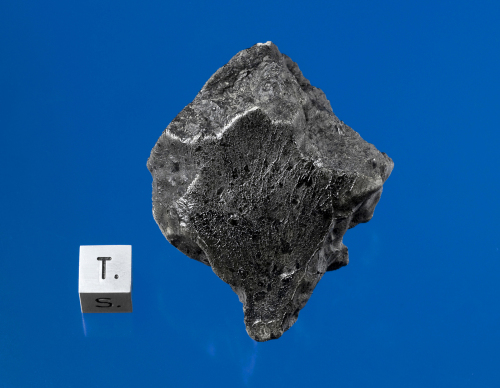WASHINGTON (AP) -- They came from Mars, not in peace, but in pieces.
Scientists are confirming that 15 pounds of rock collected recently in Morocco fell to Earth from Mars during a meteorite shower last July.
This is only the fifth time in history that scientists have chemically confirmed Martian meteorites that people witnessed falling. The fireball was spotted in the sky six months ago, but the rocks were not discovered on the ground in North Africa until the end of December.

This is an important and unique opportunity for scientists trying to learn about Mars' potential for life. So far, no NASA or Russian spacecraft has returned bits of Mars, so the only samples scientists can examine are those that come here in meteorite showers.
Scientists and collectors are ecstatic, and already the rocks are fetching big bucks because they are among the rarest things on Earth, rarer even than gold. The biggest rock weighs more than 2 pounds(1 kilogram).
``It's Christmas in January,'' said former NASA sciences chief Alan Stern, director of the Florida Space Institute at the University of Central Florida. ``It's nice to have Mars sending samples to Earth, particularly when our pockets are too empty to go get them ourselves.''
A special committee Tuesday of meteorite experts, including some NASA scientists, confirmed test results that showed the rocks came from Mars, based on their age and chemical signature.
Astronomers think millions of years ago something big smashed into Mars and sent rocks hurtling through the solar system. After a long journey through space, one of those rocks plunged through Earth's atmosphere, breaking into smaller pieces.
Most other Martian meteorite samples sat around on Earth for millions of years _ or at the very least, decades _ before they were discovered, which makes them tainted with Earth materials and life. These new rocks, while still probably contaminated because they have been on Earth for months, are purer.
The last time a Martian meteorite fell and was found fresh was in 1962. All the known Martian rocks on Earth add up to less than 240 pounds.
The new samples were scooped up by dealers from those who found them. Even before the official certification, scientists at NASA, museums and universities scrambled to buy or trade these meteorites.
``It's incredibly fresh. It's highly valuable for that reason,'' said Carl Agee, director of the Institute of Meteoritics and curator at the University of New Mexico. ``This is a beauty. It's gorgeous.''
Meteorite dealer Darryl Pitt said he is charging $11,000 to $22,500 an ounce and has sold most of his supply already. At that price, the Martian rock costs about 10 times as much as gold.
One important decision the scientists made Tuesday was officially to connect these rocks to the fiery plunge witnessed by people and captured on video last in mid 2011. The announcement and the naming of these meteorites, called Tissint, came from the International Society for Meteoritics and Planetary Science, which is the official group of 950 scientists that confirms and names meteorites.
Tony Irving of the University of Washington did the scientific analysis on the rocks and said there is no doubt they are from the red planet. Several of the world's top experts in meteorites told The Associated Press that they, too, are convinced.
Scientists can tell when meteorites are from Mars because they know what the Martian atmosphere is made of, thanks to numerous probes sent there. The chemical signature of the rocks and the Martian air match, Irving said.
Another clue is that because Mars is geologically active, its rocks tend to be much younger _ millions of years old instead of hundreds of millions or more _ than those from the moon or asteroids.
Most of the known Martian rocks on Earth have been around for centuries or longer and have been found in Antarctica or the desert. They look so similar to dark Earth rocks that if they fell in other places, such as Maryland, they would blend right in and never be discovered.
Because known Martian meteorite falls happen only once every 50 years or so _ 1815 in France, 1865 in India, 1911 in Egypt and 1962 in Nigeria _ this is a once-in-a-career or even a once-in-a-lifetime event.
Jeff Grossman, a NASA scientist who is the meteorite society's database editor, said there is a higher probability of finding ``something interesting'' from Mars on these rocks because they fell so recently. However, six months is a long time for Earthly contamination to occur, he said.
University of Alberta meteorite expert Chris Herd, who heads the committee that certified the discovery, said the first thing he would do with the rocks would be to rinse them with solvents to try to get rid of earthly contamination and see what carbon-based compounds are left.
But Cornell University astronomer Steve Squyres, who is the principal investigator for NASA's Mars Exploration Rover Program and the space agency's go-to guy on Mars, said unfortunately this type of rock is not the kind scientists are most hoping for. This find is igneous, or volcanic, rock.
A softer kind of rock that could hold water or life would be better, but that type is unlikely to survive a fiery re-entry through Earth's atmosphere, he said.
Scientists are hoping NASA and the European Space Agency will team up in 2018 to send robotic spaceships to Mars that can bring back samples of rock and dirt. Just this past weekend, a Russian probe that was going to try to bring samples back from a Martian moon came plummeting back to Earth in failure.
A Martian meteorite that was buried in Antarctica made news in 1996. NASA scientists theorized the rock showed traces of life from Mars. Even the White House declared it the first sign of life outside of Earth. Years of study since then have led much of the astronomy world to conclude there was insufficient evidence to support the claim.
<한글기사>
모로코서 발견된 화성 운석, 금값10배
(연합뉴스) 지난해 7월 모르코에 떨어진 돌들이 화성 운석(隕石)인것으로 밝혀졌다.
미국 항공우주국(NASA) 과학자들이 포함된 운석 전문가 특별위원회는 18일(현지시간) 최근 모로코에서 수집된 15파운드에 이르는 여러 돌이 화성에서 떨어진 운석 임을 확인했다.
분석 결과, 이 암석들과 화성 대기의 화학적 특징이 일치했고 화성의 지질학 연대와도 일치했다. 화성 운석임이 확인된 것은 이번이 5번째다.
1815년 프랑스, 1865년 인도, 1911년 이집트, 그리고 1962년 나이지리아에서 발견된 운석도 근래 들어 화성 운석으로 밝혀졌다.
이번 운석이 낙하하는 모습은 6개월 전 북아프리카 상공에서 목격됐다.
천문학자들은 수백만 년 전에 거대한 물체가 화성과 충돌한 뒤 떨어져나온 여러 개 암석 파편이 퍼져 나갔고 이 중 일부가 지구 대기권 안으로 들어온 것으로 보고 있다.
과학자들은 이번 발견이 화성에 생명체가 존재할 가능성을 연구할 좋은 기회가 될 것으로 보고 있다.
이는 지금까지 미국 항공우주국(NASA)이나 러시아가 쏘아 올린 화성 탐사선들은 화성의 표본을 가지고 지구로 돌아오지 못했기 때문이다.
특히 다른 화성 운석 대부분은 지구 상에 수백 년 혹은 수십 년 동안 있다가 뒤 늦게 발견돼 지구의 물질이나 생명체에 오염됐었다.
하지만, 이번 운석들은 낙하에서 발견까지 불과 몇 달 만에 이뤄져 상대적으로 오염도가 덜하다.
그러다 보니 이 운석들은 벌써 금보다 훨씬 비싼 값에 거래되고 있다.
공식 화석 운석임을 인증받기도 전에 NASA와 박물관, 대학들이 앞다퉈 사들인 것으로 전해졌다.
운석 중개상인 대릴 피트는 온스당 1만1천달러에서 2만2천500달러까지 값을 불렀는데, 대부분 물량이 이미 팔렸다고 전했다.
이는 금값의 10배에 달한다. 일부 운석은 무게가 2파운드(1㎏)가 넘는 것으로 전해졌다.








![[New faces of Assembly] Architect behind ‘audacious initiative’ believes in denuclearized North Korea](http://res.heraldm.com/phpwas/restmb_idxmake.php?idx=644&simg=/content/image/2024/05/01/20240501050627_0.jpg&u=20240502093000)









